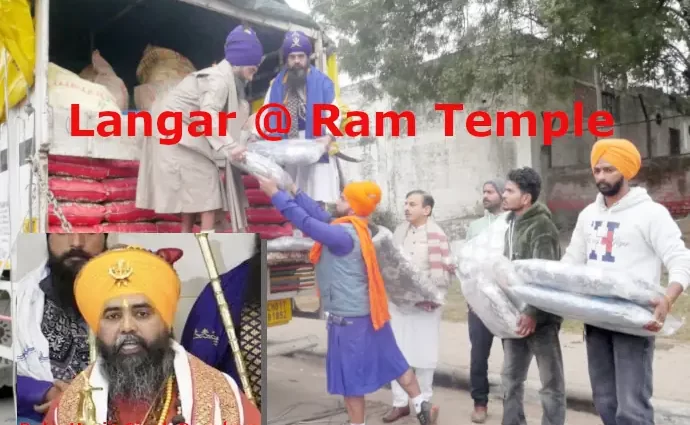Baba Harjit Singh Rasulpur organized ‘langar sewa’ (community kitchen offering free food for all) at Ayodhya well before the Pran Pratishtha on January 22. He says his forefathers eight generations back led the claim of Ram temple back in the 1850s. To be precise, in November 1858, Nihang Baba Fakir Singh Khalsa, his family elder then, barged into Babri Masjid in Ayodhya, conducted a hawan and wrote ‘Ram Ram’ on the walls of the mosque.
“I am the eighth generation of Baba Fakir Singh and want to highlight the sacrifices of Nihangs among Ram devotees,” said Harjit Singh, a member of the Nihang Sikh group.
“This langar is a tribute to the struggle launched by our ancestors for the construction of the Ram temple in Ayodhya. The service will go on for two months,” Harjit told the Indian media.
He is openly advocating for Hindu-Sikh Sanatan unity and bursts any myths of the rift and the imaginary Khalistan.
Standing out among Hindus who have waited for the opening of the temple for more than 500 years, is a group of Nihang Sikhs who have been “langar sewa” in the Char Dham mutt for the pilgrims who arrive at the temple. The sewa will run for at least two months.
Also read: Fatwa issued against the Chief Imam for attending Ram Temple Pran Pratishtha @Ayodhya
The connection of Sikhs to Ram Janmabhoomi is a real one and documented in the history books.
Guru Nanak Dev’s Ayodhya visit
The Supreme Court of India in its 2019 judgement on Ram Temple finds that Guru Nanak Dev ji, the founder of Sikhism, as part of his pilgrimages undertaken after enlightenment, visited the site of Ram Janmabhoomi in Ayodhya in 1510-11 AD. Babri Masjid was not constructed at the time.
A witness by the name of Rajinder Singh not only gave evidence in court but also produced ‘various Janma Sakhies, recording the Ayodhya visit of Guru Nanak Dev ji and visiting the Ram Janma Bhumi for Darshan.
Guru Teg Bahadur and Guru Gobind Singh’s Ayodhya visit
The Janma Sakhies referred to by the Supreme Court of India in its judgement also refer to Shri Guru Teg Bahadur and his son Shri Guru Gobind Singh also visiting Ayodhya for the Darshan of Shri Ram Janam Bhumi.
It is not surprising thus to hear that Nihang Baba Fakir Singh Khalsa stormed into the masjid in 1858 and took control by conducting ‘havan’ and pooja and writing Ram Ram on the walls inside, claiming ownership.
In Punjab also Hindus and Sikhs joined to celebrate Ram mandir inauguration.
In Dangar Khera, about 15 km from the Pakistan border in Punjab’s Fazilka district, the committees of five temples and a gurdwara together prepared a langar as the population of 10,000—70 per cent of them Hindus—celebrated the pran pratishtha at the Ram mandir in Ayodhya on Monday.
“We made kheer, dal and roti… the way we make langar during gurpurab. The same way we did on this occasion as well. Harphool Singh Mann was very kind as he gave all the space in his house to cook the langar,” Narayan Chaudhary, a farmer, was quoted saying by The Indian Express.
Similar Posts by The Author:
- Free Broadband for Greater Dandenong Students
- If you are getting out and about, here is the transport alert for 19 April – 25 April
- V/line travellers enjoy the capped fare bonanza
- Pool tragedy: Dharmvir, his father Gurjinder drown trying to save 2YO daughter
- Victorians pay $198.38 million more, thanks to Labor’s IT mismanagement

